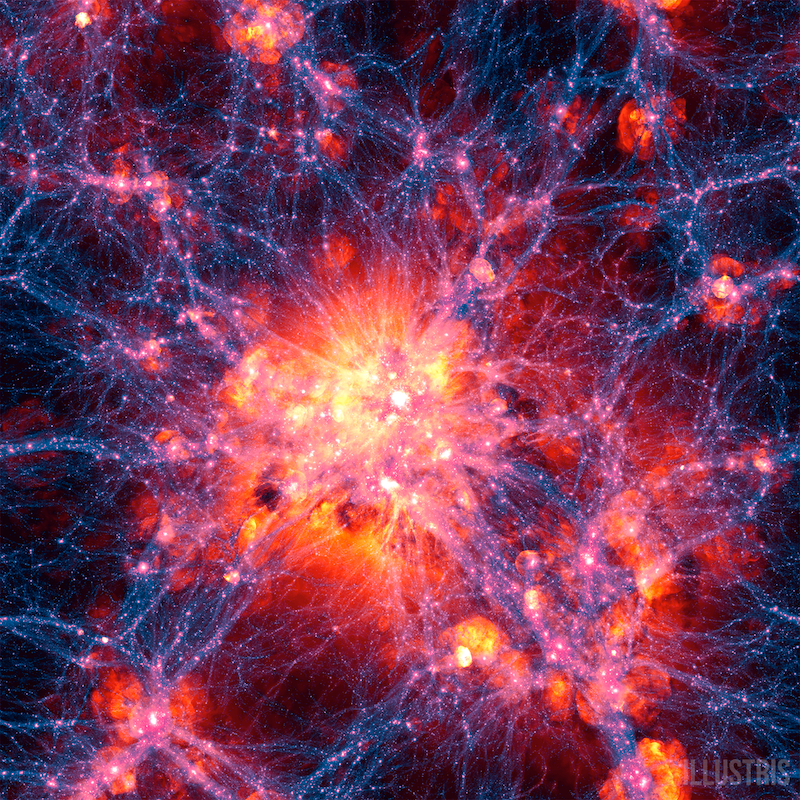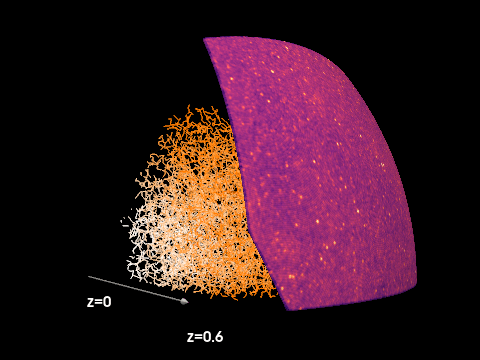
A frame from the Illustris Simulation shows a massive galaxy cluster at center. Red, orange, and white colors show hot gas, while the blue and purple filaments depict a cosmic framework of dark matter. Credit: Illustris Collaboration
The game is afoot! Astronomers may have found some of the universe’s missing matter, thanks to one team’s cosmic detective work.
The case has been open for more than 20 years. In the 1990s and early 2000s, scientists sleuthed out the universe’s contents using observations from the cosmic microwave background radiation and Big Bang models. They found that normal matter (made of familiar particles like protons and neutrons, collectively called baryons) makes up about 4 to 5 percent of the cosmos’ total energy density. (The remainder of the cosmos is made up of two mysterious components: dark matter and dark energy.)
The problem: Astronomers could only locate around half of those baryons. Adding up all the visible baryons in stars, galaxies, and gas clouds left the other half unaccounted for.
Scientists have gradually chipped away at this mystery, dubbed the missing baryons problem, in years since. In the last few years, researchers studying fast radio bursts — blasts of radio waves from space lasting only a few milliseconds — have used their data to confirm the total number of expected baryons. Their results are consistent with the cosmic microwave background, which holds clues about the total amount of normal matter in the universe. But the number was still more than we were seeing — it remained unclear where exactly the missing baryons were located.
Theoretical models of the cosmic web — a network of galaxies, gas, and dark matter spread throughout the universe — predict that these baryons might be tucked away in material called the warm-hot intergalactic medium (WHIM), spread along tendrils of gas that connect galaxy clusters. But detecting this “ghost” matter is extremely difficult, since gas in the WHIM is spread extremely thin, averaging just 10 particles per cubic meter (1 cubic meter is equal to about 35 cubic feet).
Our own galaxy complicates matters even further. The WHIM gives off so-called soft (lower-energy) X-rays, which are absorbed by the Milky Way’s foreground gas and dust that we have to look through. And gas in the WHIM is extremely faint, so telescopes need high sensitivity and long exposure times to collect enough photons to study it.
Clues from cosmic fog
In a study published today in Astronomy & Astrophysics, scientists have released the most detailed view of the WHIM to date and made significant progress in unraveling the mystery of the missing baryons. The team stacked X-ray observations from the extended ROentgen Survey with an Imaging Telescope Array (eROSITA) to precisely measure the gas in nearly 8,000 filaments of gas in the WHIM, some of which span up to 65 million light-years.
The team also measured the temperature of the gas in the WHIM. At about 10 million degrees Fahrenheit (5.6 million degrees Celsius), it’s so hot that it must be made of charged particles because the heat has stripped atoms of their electrons. That’s important because it affects how the gas absorbs or emits light, which in turn helps astronomers estimate how much gas is there.
Then they measured the density of the gas. Coupling the temperature and density allowed them to approximate the total amount of baryonic matter in the WHIM. And the team calculates there could be enough to account for 20 percent of the universe’s missing baryons, though the uncertainty is large. Ongoing multi-wavelength surveys should greatly improve the precision of this estimate within this decade.
“This is one of the big questions in astrophysics and cosmology, along with mysteries like dark energy and dark matter,” says Esra Bulbul, an astrophysicist at the Max Planck Institute for Extraterrestrial Physics (MPE), who co-authored the paper. “People have been searching for these baryons for a long time, so it’s very exciting to find a significant portion of them.”

An ongoing investigation
Still, the case is far from closed.
“The team relied on single average values for several parameters, including the temperature and heavy element abundance,” says Michael Shull, a professor of Astrophysical and Planetary Sciences at the University of Colorado—Boulder, who is not an author on the study. He has studied the missing baryons problem for over 15 years. The WHIM’s heavy element content serves as a tracer for the total amount of baryons it contains. “Nailing down the way the temperature varies would help refine the measurements, as would careful geometric studies that more precisely trace the spatial extent of the WHIM filaments.”
Combining observations from different wavelengths of light to get a more complete view of the WHIM is one of the next steps, Bulbul says. That would better constrain the temperature and density of gas, yielding a more accurate baryon tally. That, in turn, will help us better understand the universe.
“Studying this gives us a way to test cosmological simulations by comparing them with observations,” Bulbul says. “That will help us learn how the universe has evolved to its present state and how it may continue to evolve in the future.”
Xiaoyuan Zhang, a postdoctoral researcher at MPE who led the study, says finding the missing baryons will also illuminate galaxy evolution. “The space surrounding galaxies isn’t a perfect vacuum,” he says. “There’s gas there, and it influences things like the transformation of a galaxy’s color, shape, and star forming rate.”
Scientists are slowly but steadily resolving the missing baryons problem. As our tools and techniques improve, the remaining baryons will likely be identified — and if not, we may stand to learn even more about the cosmological model that predicts they should exist.

